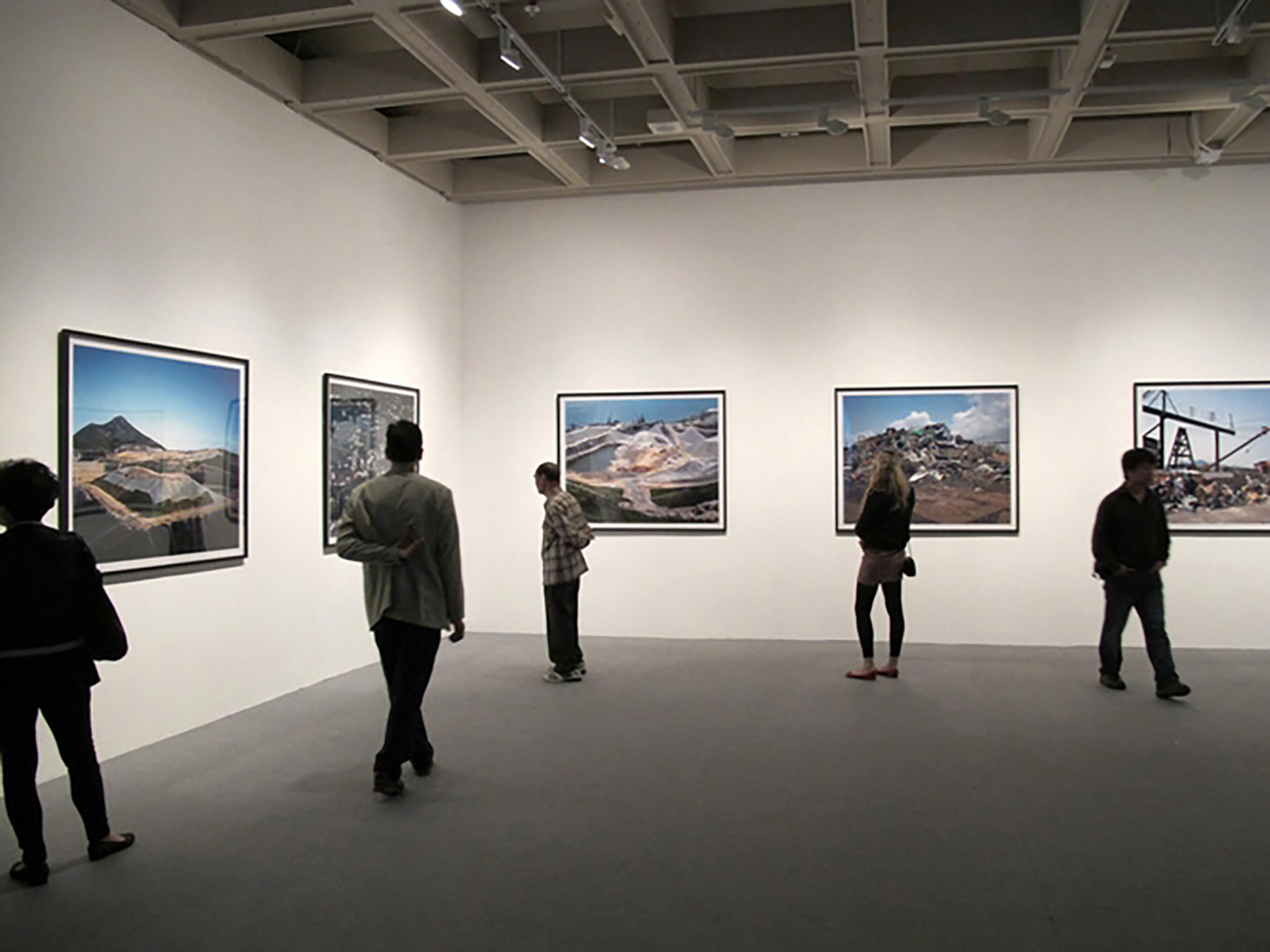 |
|
Five photos of the ”Artificial Landscapes” Series by Almond Chu were exhibited at the Hong Kong Museum of Art in 2011. |
 |
|
Five photos of the ”Artificial Landscapes” Series by Almond Chu were exhibited at the Hong Kong Museum of Art in 2011. |
Almond Chu Tak-wah is a photographer/artist from Hong Kong specializing in portraits. He has taken photographs of many vital figures in the arts and cultural sectors, including Hong Kong film director Wong Kar Wai, Beijing-born poet Bei Dao, Chinese artist Ai Weiwei, etc. Art critics generally describe his works as classical and straightforward [1]. He graduated from the Fine Art Photography Department, Tokyo College of Photography, Japan, and started his artistic creation in 1980. He used a square format to shoot black and white human bodies in the early days. In 1993, he opened a studio and was awarded the Agfa Fellowship Young Photographer Award by the Asian Cultural Council in the same year.
His works have been exhibited in Germany, France, Switzerland, Italy, Denmark, the United States, Russia, Japan, China, Hong Kong, New Zealand, and other places. In 2015, he was nominated for the Prix Pictet Prize for Photography and Sustainability. His works have been collected by the Pushkin State Museum of Fine Arts in Moscow, Hong Kong M+ Museum, Hong Kong Museum of Art, Hong Kong Heritage Museum, Guangdong Museum of Art, University Museum and Art Gallery of the University of Hong Kong, OCT Art & Design Gallery Shenzhen, Osage Gallery, Lee Hysan Foundation, Deutsche Bank, Peninsula Hotel Hong Kong, Mandarin Oriental Hotel Taipei, New World Development Co., Ltd., Cathay Pacific Airways, etc.
Besides portraits, Almond Chu also took environmental photos, including "Sky" (2007-present), which focuses on air pollution, "The City Of Ruins"(2009) with the theme of the 2008 Wenchuan earthquake, "Time Tunnel" (2018), which captures metal water pipes for supplying drinking water, etc. In this research project, we will focus on the "Artificial Landscapes” series (2004-2016), which is a photography project around garbage, artificial construction, and other issues[2].
"Artificial Landscapes” is a series of photographs that explores the coexistence relationship between man and nature. The entire series does not have any portraits, but it is full of traces of human intervention in nature. "We all say that Hong Kong has a huge population on very scarce land. How do we change the landform here in a city where people and the land are so closely in contact?" Almond Chu said in an interview with the research team. In other words, he understands the city as a habitat. And he re-looks at the relationship between people and living space from this perspective.
Photographers of his generation have explored different urban spaces. For example, Wong Wo Bik photographed Lai Yuen Playground from a partial perspective, Lau Ching Ping photographed roads and tall buildings from a long distance, and So Hing Keung photographed plants and buildings with double exposure. Almond Chu used an 8 X 10 camera to capture Hong Kong’s landfills and construction waste disposal sites. "Technically speaking, after narrowing the aperture, the 8 X 10 camera has better depth of field effect than the 135 camera, which makes both front and back scenes of the photo equally clear. When the photo is enlarged to 120cm X 150cm, there will even emerge a surreal feeling." Almond Chu added. Carmen Lee, who held an exhibition for him at the University Museum and Art Gallery, The University of Hong Kong, wrote in the exhibition statement: "The use of high-resolution film is essential to Chu’s photographs. Viewers have to look at the details to appreciate the pictures fully. The detailed images of litter in ditches and bird’s eye views of wastelands are unobtrusive, corresponding to the detachment of the new documentary. The photos by Chu are a melange of dichotomies. He focuses on the details of reflections within a rubbish-filled ditch as a landscape photographer would on reflections in a still pond. " [3]
The entire series of "Artificial Landscapes" has nearly 40 photos. These photos recorded nature (mountains, water) and artificial objects (landfills, mines, racecourses, public housing estates, etc.). Almond Chu spent more than ten years, from 2004 to 2016, completing this series. In one of the works, he applied the Chinese calendar cycle as a concept, using a camera to capture Chai Wan’s public housing estate changes within 12 years. When you put before and after photos together, you would see the tree in the estate grows, from the height of the 5th floor to the 9th floor. And the wall of the building changed from green to white and purple due to renovation.
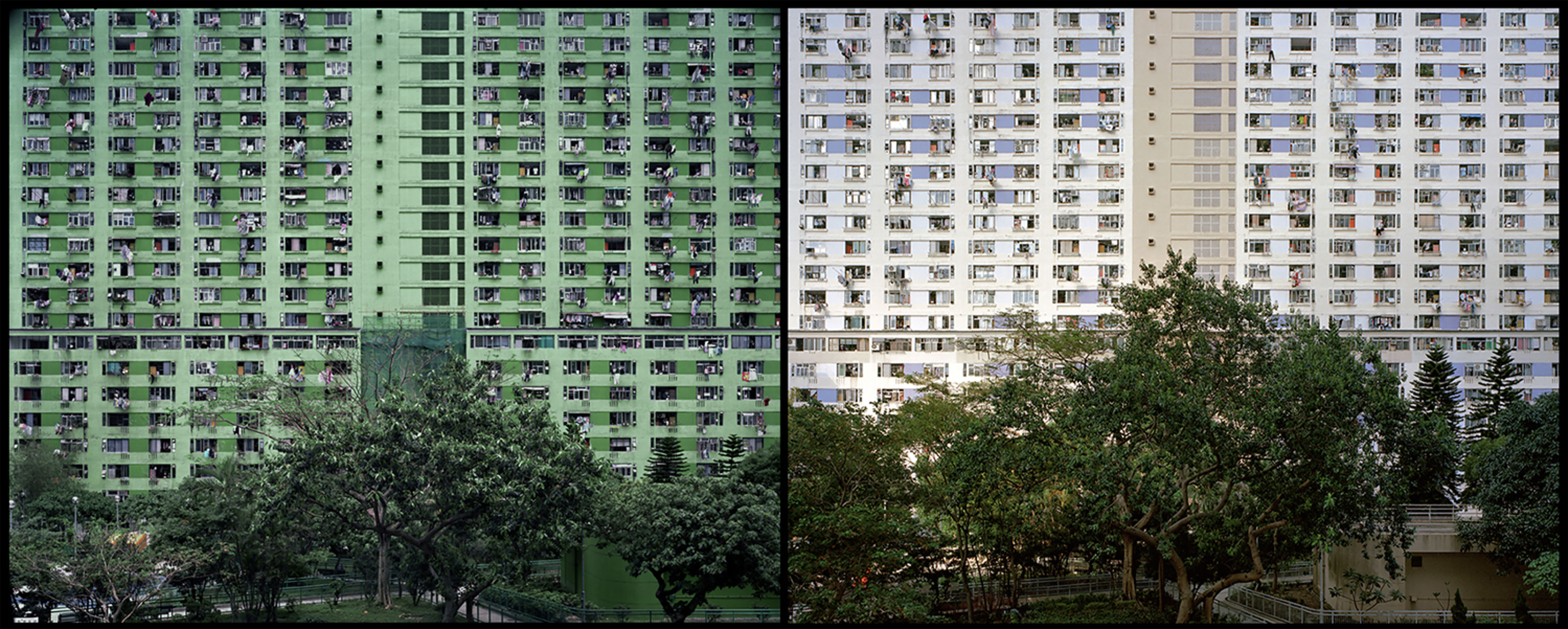 |
|
“Public Estate Hong Kong” by Almond Chu, 2004/2016 |
The whole series starts with these two photos of "Rubbish Floating On Reservoir Hong Kong" (2004). In 2004, the artist went to the Tseung Kwan O Cemetery for work but saw that the reservoir inside was filled with trash. His first reaction was that the garbage moved slowly with the wind on the water, like an abstract painting. So he took this picture with an 8 X 10 camera: different plastic bottles, white foam lunch boxes, yellow paper-packed beverage packages, and so on, floating on the close-to-black water. The garbage was irregularly covered on the screen. The artist took two photos in the same place, showing the slow movement of waste, and combined them into a diptych. Starting from this group of images, the artist began to pay attention to the problem of urban garbage, so he began to collect information to find space related to waste in Hong Kong.
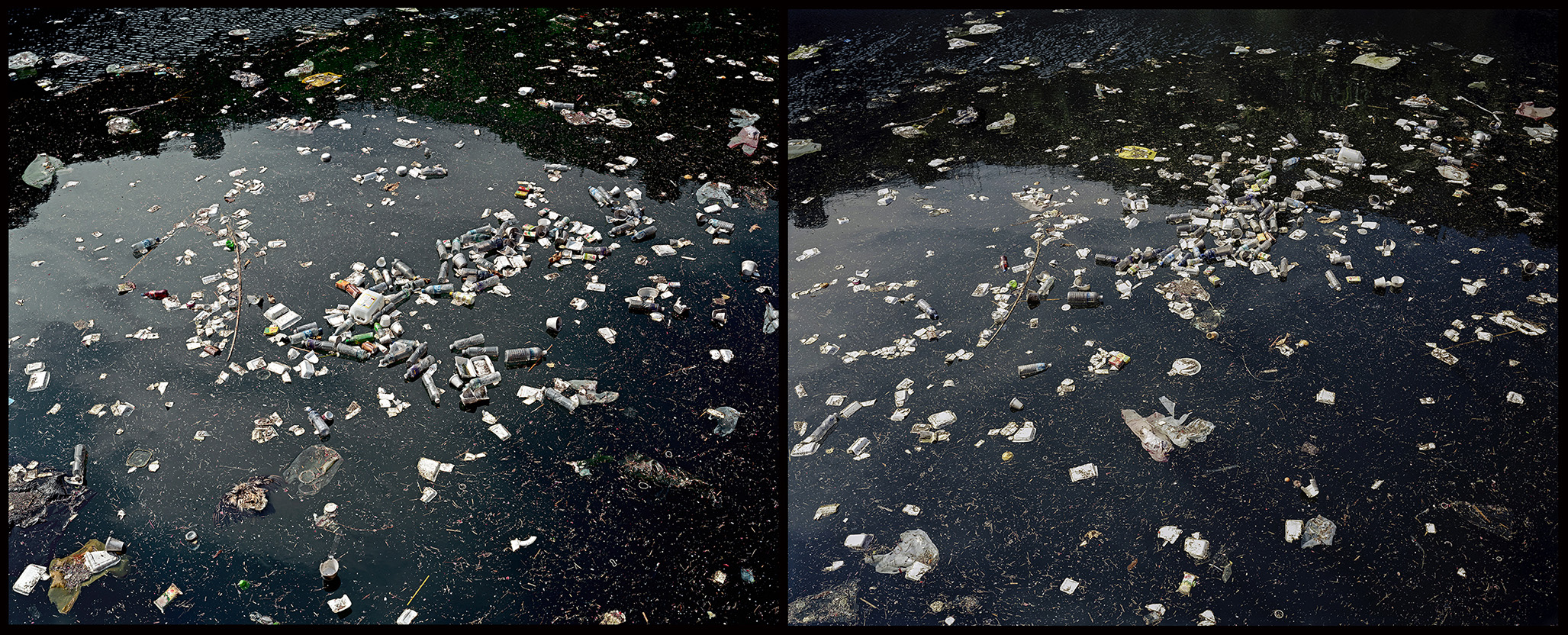 |
|
"Rubbish Floating On Reservoir Hong Kong (diptych)" by Almond Chu, 2004. This work is collected by the Hong Kong Museum of Art and the Hong Kong Heritage Museum. |
After that, he photographed the Tseung Kwan O landfill. There have been three landfills in Tseung Kwan O, namely Tseung Kwan O Phase 1 Landfill (1978-1995), Tseung Kwan O Phase 2 and Phase 3 Landfills (1988-1994) and South East New Territories Landfill (1993-). The first two have been restored and turned into recreational and open spaces[4]. The South East New Territories Landfill is strategic. Only construction waste has been accepted since 2016 in response to the government's waste diversion plan. The artist photographed in 2004 when the landfill[5] had not yet been classified.
"Photographing landfills is very troublesome and requires a lot of applications." The artist shared with the team. So he simply bypassed the application, climbed up the mountain opposite Tai Chik Sha(where The South East New Territories Landfill is located), and photographed the landform of the landfill from a distance. "At that time, the staff in the landfill yelled to me not to shoot at the foot of the mountain, but I was not in the landfill so he couldn't do anything with me." Almond Chu recalled. The skies in the two photos are so blue because Almond Chu took them in winter.
The composition of these two photos exactly shows the artist's understanding of the entire series of "Artificial Landscapes.” The upper part of the picture is the natural landscape, including blue sky and mountains. The lower part is human intervention, including the artificial hills and car roads piled up with garbage. The natural landscape and human intervention overlap each other. The 8 X 10 camera presents both on a 1.5-meter-long photo paper, forming different kinds of artificial landscapes. He also invites the audience to watch how humans change their place of growth with magnified eyes.
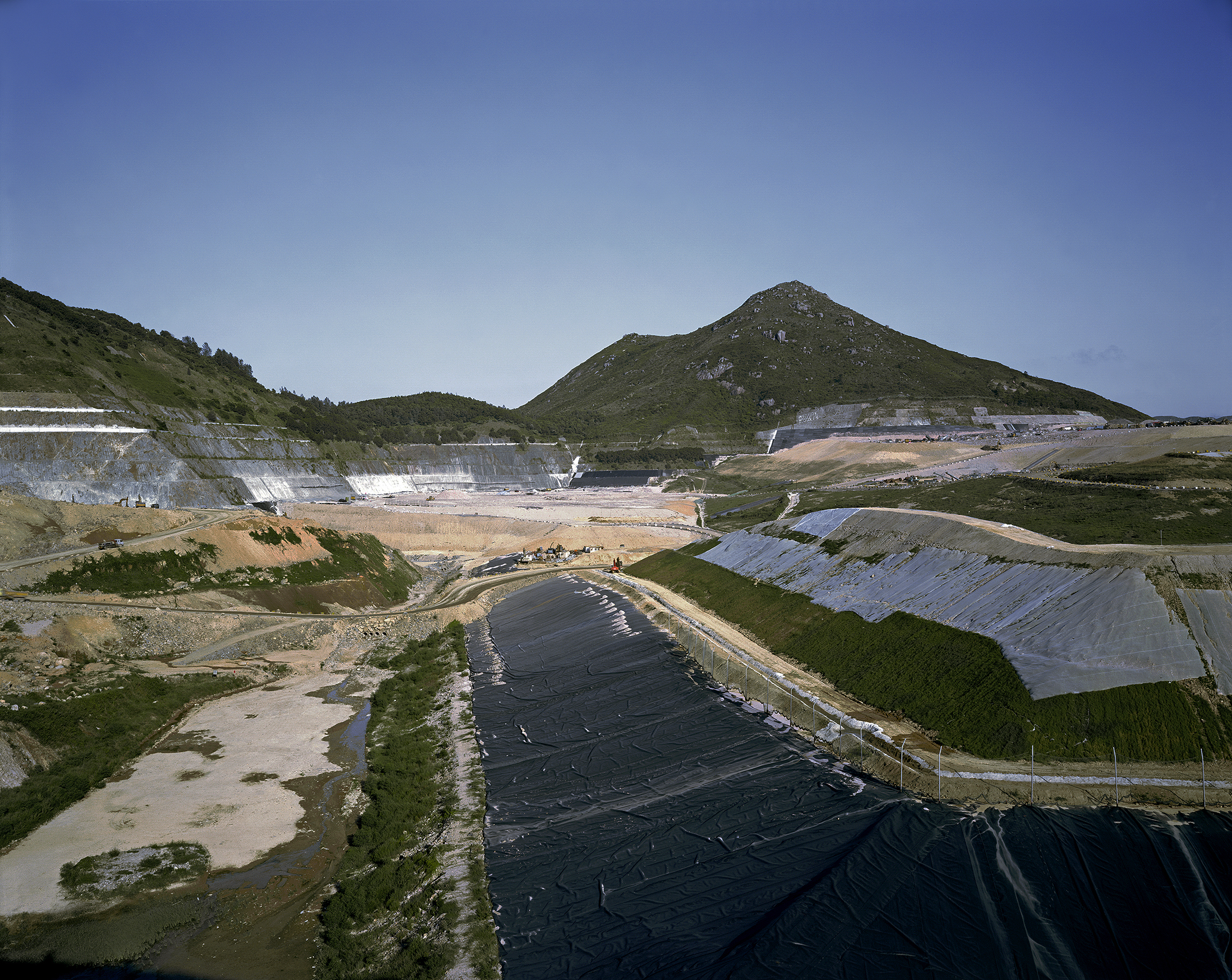 |
|
“Landfill Hong Kong” by Almond Chu, 2004. |
 |
|
“Landfill Hong Kong” by Almond Chu, 2004. This work is collected by the Hong Kong Museum of Art, the Hong Kong Heritage Museum, Guangdong Museum of Art, and the Lee Hysan Foundation. |
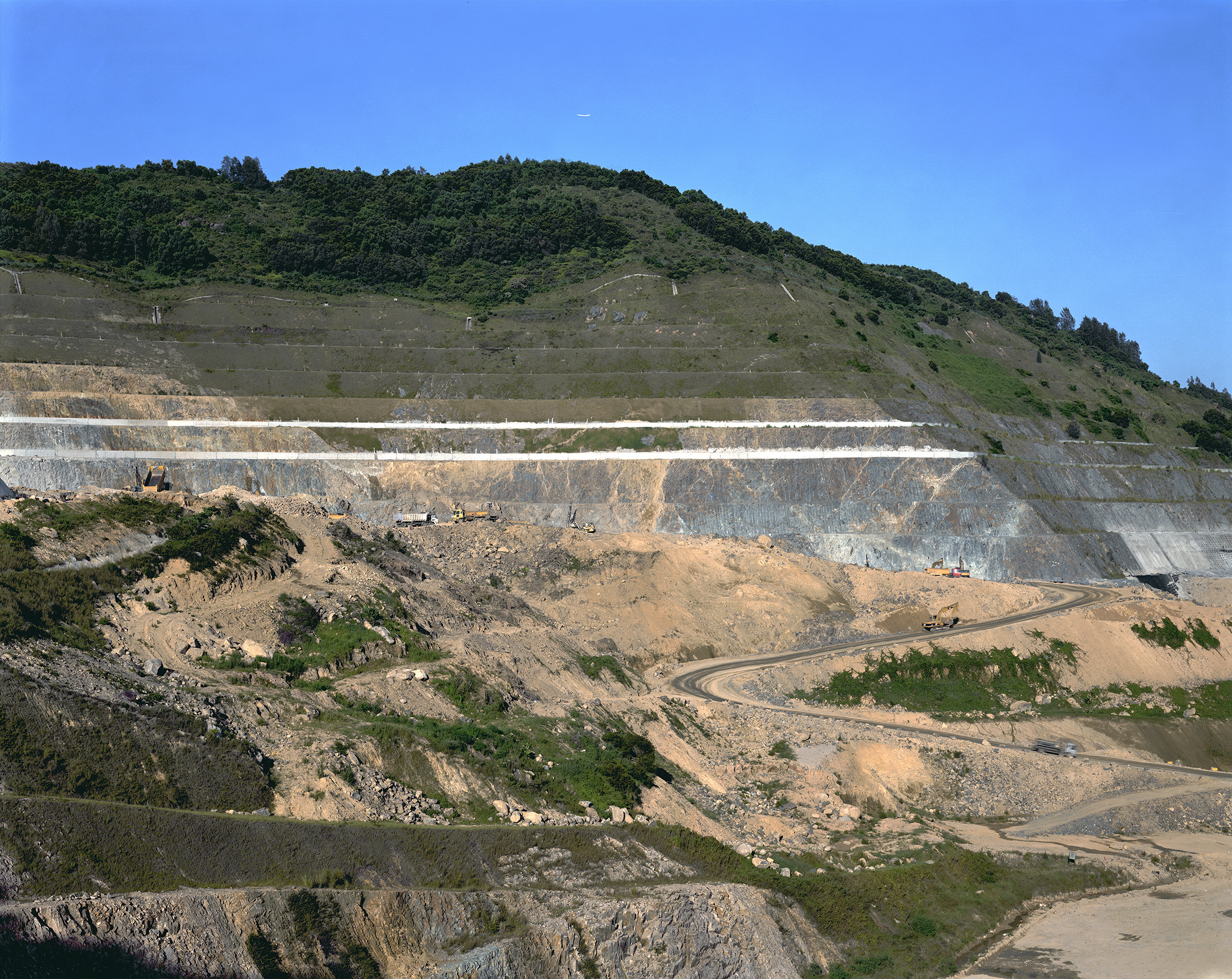 |
|
“Landfill Hong Kong” by Almond Chu, 2004 |
In addition to the landfill, Almond Chu also cares about the garbage in the urban area, so he went to the Island East Waste Transfer Station in Chai Wan to take photos. The waste transfer station collects and compresses the urban waste, then puts the waste into special containers and transports them to the landfill for disposal. Chu’s studio is located in Chai Wan. He discovered that there was a waste transfer station where he works every day, so he used his camera to find the process of garbage disposal. From a bird's-eye view of his studio, he photographed containers full of garbage, transfers from Chai Wan to Tseung Kwan O every day. Later, he walked directly to the transfer station to take close-up shots of the waste paper and plastic bottles. The artist uses film to capture both natural and artificial landscapes in these four photos. In "Refuse Transfer Station Hong Kong" (2004), the artist deliberately put the artificial garbage dump and the natural mountain ridge behind it in the same picture. In addition, there are three enlarged photos of garbage, which are one of the few in the whole series to view litter from an enlarged angle.
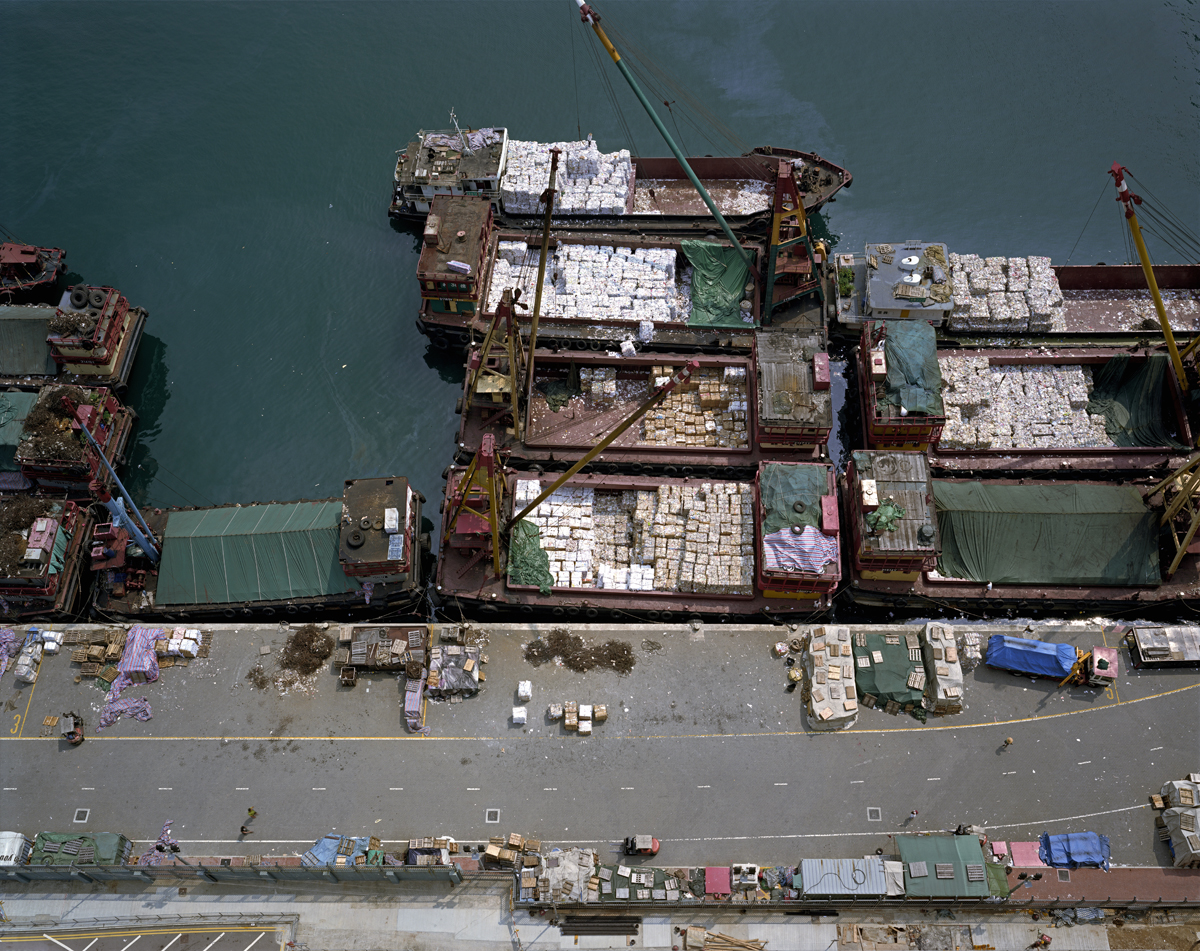 |
|
“Refuse Transfer Station Hong Kong” by Almond Chu, 2005. This work is collected by the Hong Kong Museum of Art. |
 |
|
“Garbage Disposal Station Hong Hong” by Almond Chu, 2004. This work is collected by the Hong Kong Museum of Art and University Museum and Art Gallery of HKU. |
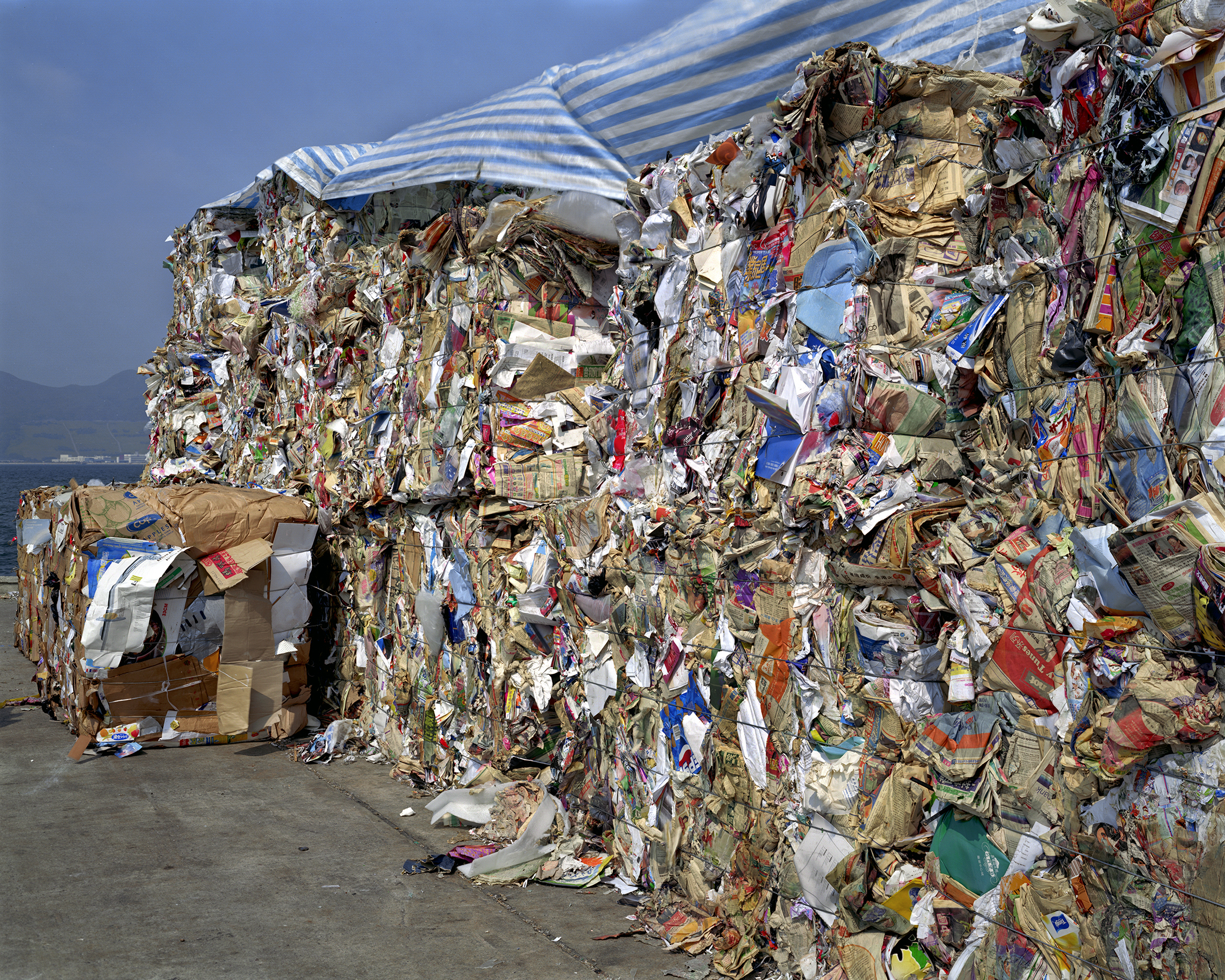 |
|
“Waste Paper Hong Kong” by Almond Chu, 2004 |
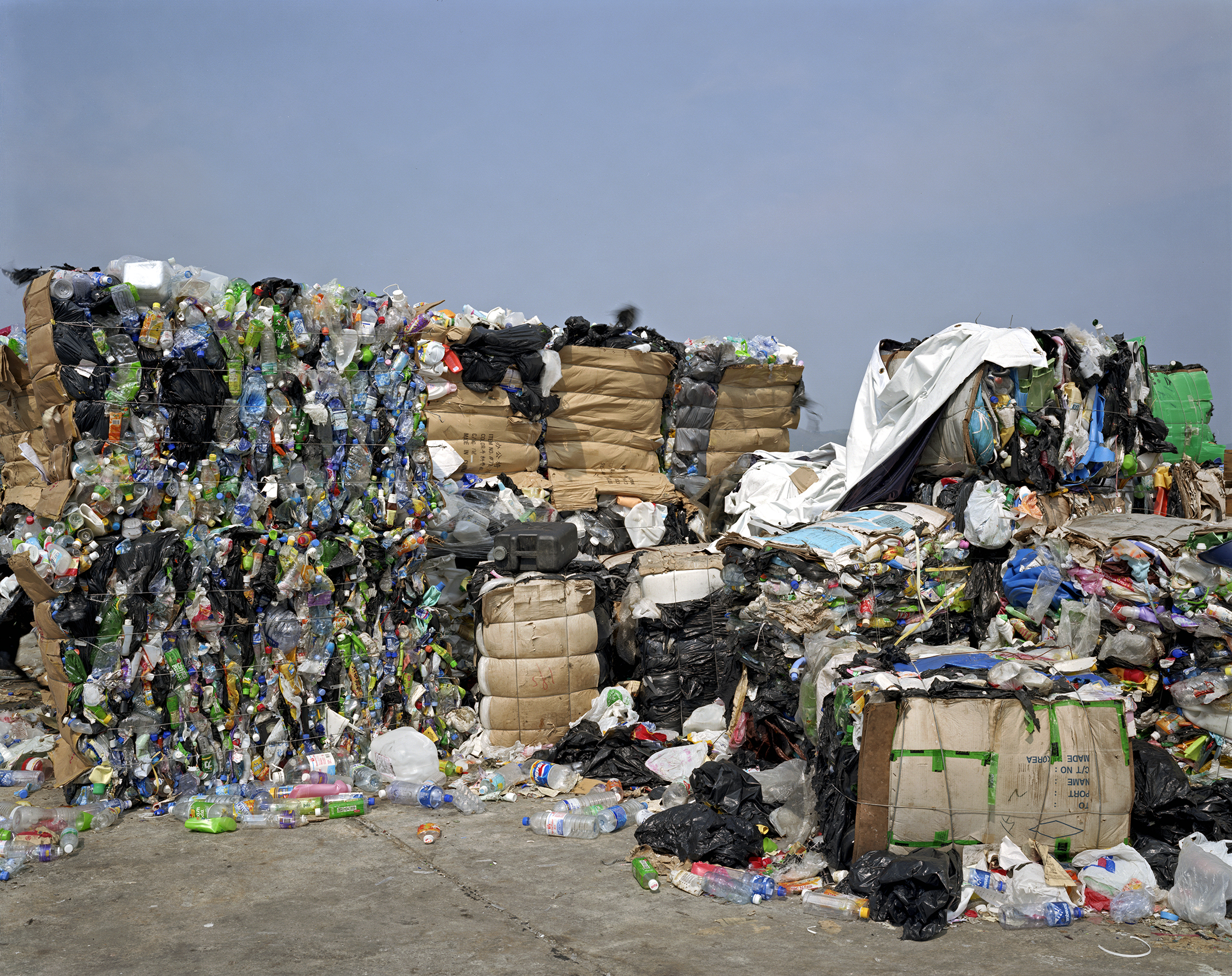 |
|
“Waste Paper Hong Kong” by Almond Chu, 2004 |
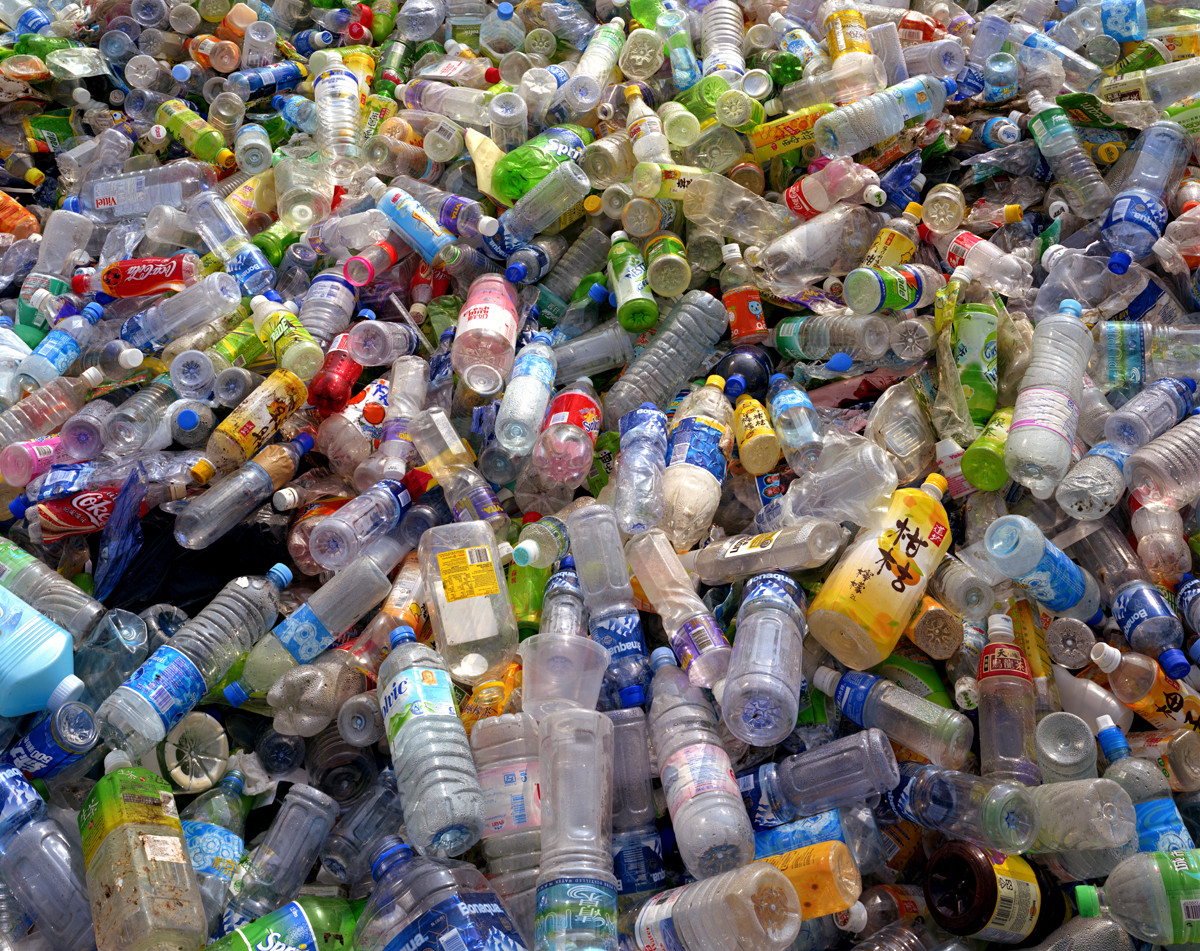 |
|
“Waste Paper Hong Kong” by Almond Chu, 2004 |
Among the many types of garbage, construction waste is challenging to deal with. Construction waste refers to any material generated by construction projects. Site leveling, excavation, building construction, decoration, renovation, demolition, and road projects will cause surplus materials. More than 90% of the construction waste in Hong Kong is inert materials, which is generally called public fill. The current problem is that Hong Kong’s current filling areas and landfills are insufficient to contain these construction wastes [6]. Construction waste is a public concern today, especially after the Land Justice League revealed the Rubble hills issue in 2016 [7]. However, in 2004, construction waste was not a topic of particular concern to the public. In WiseNews, we searched for news on construction waste in Hong Kong in 2004[8]. There were only about 100 new reports on construction waste throughout the year. Half of it was related to the Redhill Peninsula, mainly from the perspective of the real estate industry. Only one report can be found when the news search is narrowed down to "Yuen Long, construction waste" [9]. As early as 2004, Almond Chu had discovered the illegal dumping of construction waste in Yuen Long and recorded it with a camera. In 2008, Pacific Century Premium Developments built a show flat of Bel-Air Bay at the coast of Cyberport, which was demolished after only one year of use. There were few media reports at the time[10]. Almond Chu also went to the Cyberport to take photos of the disposable landscape of the show flat with a photo composition similar to that of the landfill photos (natural landscape above, human intervention below).
 |
|
“Construction Waste Hong Kong” by Almond Chu, 2004. This work is collected by the Hong Kong Museum of Art and Hong Kong Heritage Museum. |
 |
|
"Construction Site for Sample House (Dismantle)" by Almond Chu, 2008. |
There have been many art projects related to garbage issues in recent years. Compared with Beijing’s garbage besieged city, Almond Chu’s goal was not to get the public’s attention with a visual shock. In contrast to the “Ubiquitous Trash” photography project [11], the winning project of the WMA Commission produced by Mexican art collective TRES, Almond Chu never wanted to conduct sociological discussions through photographs. Art critic Ann Mak wrote that this series of Chu’s works, "is not the use of documentary shooting techniques to make statements vividly, but the author uses a consistent and calm observation to conduct personal inner exploration through the lens."[12] Her observation exactly echoed the artist's statement: "To find the truth in photos (including photojournalism) is too wishful thinking." [13]. Therefore, his photographs mainly emphasize the essential elements of photos, such as light, shadow, and lines, including "Artificial Landscapes." Although this series uses landscape as the theme, the artist put a lot of effort into dealing with the aesthetic considerations of details and maintaining a consistent minimalist style. Professor Matthew Turner's footnote to this series of works is as follows: "On the display here are a set of prints that showcase the city’s latest spectacle of development: not the vertical skyline, but relatively horizontal flows of extraction and dredging, the shipping of waste and the tamping of reclamation and landfill. Chu’s work betrays no simplistic moralizing; indeed, these meticulously detailed prints could grace the annual reports of a mining consortium more quickly than they could rouse support for Friends of the Earth. "[14]
Link
Almond Chu's website:http://almondchu.com/wordpress/
© Unless otherwise stated, all photos courtesy of Almond Chu. All rights reserved.